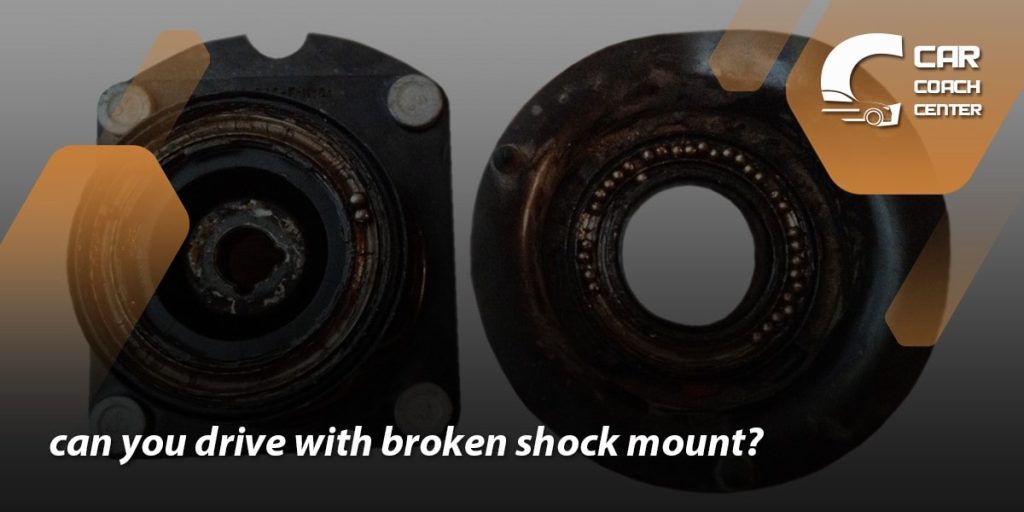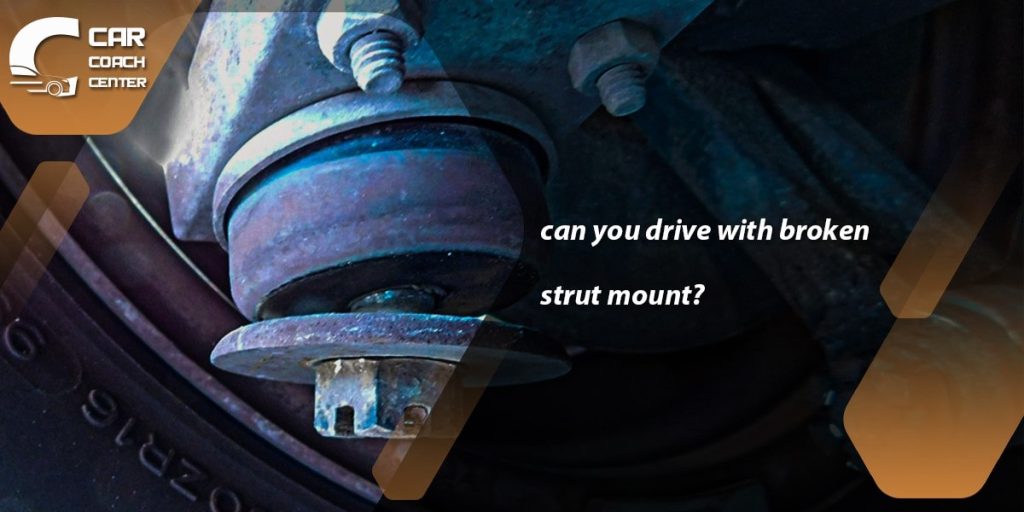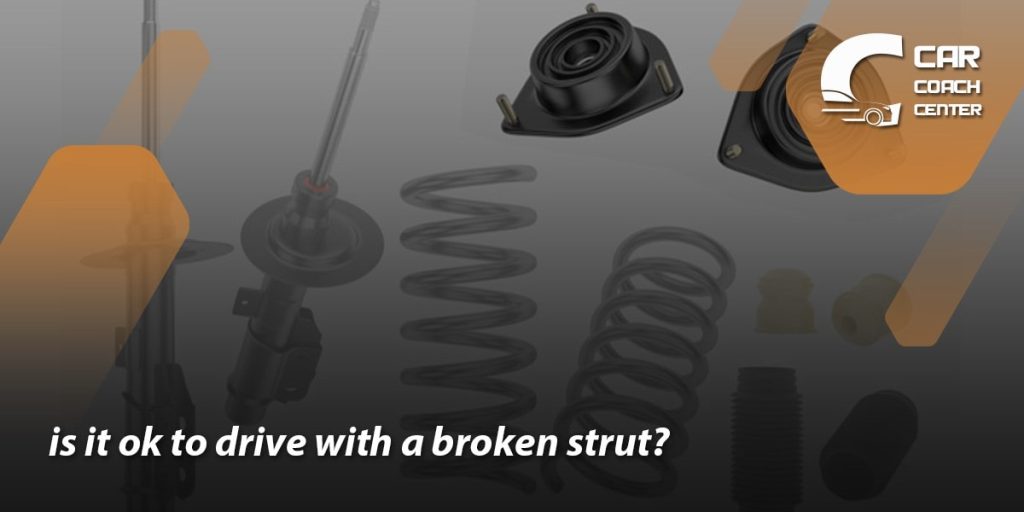Can You Drive With A Broken Strut Mount
The suspension system provides a smooth and controlled ride as you navigate the roads with your trusty vehicle. One vital component of this system is the strut mount, which serves as a connection point between the suspension strut and the vehicle’s body.
However, like any mechanical part, strut mounts are susceptible to wear and damage over time. So, what happens if you find yourself with a broken strut mount? Can you still safely drive your car? In this article, we will explore the world of strut mounts, their function, signs of damage, and the potential risks involved in driving with a broken strut mount.

Whether you’re a curious car enthusiast or facing this issue firsthand, understanding the implications and necessary actions can help you make informed decisions and ensure your safety. So, let’s uncover the truth about driving with a broken strut mount and discover the best action to take in such a situation.
Signs of a Broken Strut Mount: Unveiling the Symptoms
Your vehicle’s strut mount is critical in maintaining a smooth and stable ride. When this component becomes damaged or broken, several telltale signs may indicate a problem. By paying attention to these symptoms, you can identify a potential issue with your strut mount and take appropriate action. Here are some common signs to watch out for:
Unusual Noises
A broken strut mount can cause a variety of noises while driving. Listen for clunking, knocking, or rattling sounds coming from the front or rear of your vehicle. These noises typically occur when going over bumps, uneven road surfaces, or during turns.
Vibrations
If you feel excessive vibrations in the steering wheel, floorboard, or even the entire vehicle, it could be a sign of a broken strut mount. These vibrations may become more pronounced at higher speeds or over rough roads.
Handling Issues
A compromised strut mount can affect the overall handling of your vehicle. You may notice a decrease in stability, especially during cornering or braking. The car may feel less responsive and tend to sway or bounce.
Uneven Tire Wear
Monitor your tire tread patterns. Uneven or accelerated wear on one or more tires could indicate a problem with the strut mount, as it can affect the alignment and suspension geometry.
Visible Damage
Perform a visual inspection of the strut mount. Look for cracks, tears, or any signs of physical damage. Additionally, check for excessive movement or looseness in the strut assembly when the vehicle is stationary.
Changes in Ride Comfort
A broken strut mount can result in a harsher and less comfortable ride. If you notice a sudden deterioration in ride quality or a change in how your vehicle handles bumps, it could be attributed to a faulty strut mount.
Understanding the Role of Strut Mounts in Vehicle Suspension
A vehicle’s suspension system is responsible for absorbing shocks, providing stability, and maintaining contact between the tires and the road surface. Among the various components of this system, strut mounts play a crucial role in ensuring optimal performance. Let’s look at the function and importance of strut mounts in a vehicle’s suspension.
Strut mounts, also known as suspension mounts or bearing plates, serve as a connection point between the suspension strut (or shock absorber) and the vehicle’s body. They provide a secure attachment for the strut while allowing for smooth movement and dampening of vibrations. Strut mounts are typically located at the top of the assembly and are often made of rubber or a rubber-like material with a metal backing plate.
One of the key functions of strut mounts is to provide a cushioning effect, absorbing shocks and vibrations from the road surface. This helps to enhance ride comfort by reducing the transfer of jolts and impacts to the vehicle’s occupants. Additionally, strut mounts contribute to the overall stability and handling of the vehicle by providing a pivot point for the strut assembly during steering and suspension movements.
Another important role of strut mounts is to isolate noise and vibrations generated by the suspension system. The rubber or rubber-like material used in the construction of strut mounts acts as a barrier, reducing the transmission of noise and harshness from the suspension components to the vehicle’s interior. This helps to create a quieter and more comfortable driving experience.

Potential Risks of Driving with a Broken Strut Mount
Driving with a broken strut mount can pose significant risks to the vehicle and its occupants. While it may be tempting to ignore or postpone the necessary repairs, it’s essential to understand the potential consequences of continuing to drive in this condition. Here are some of the risks associated with driving with a broken strut mount:
Compromised Vehicle Handling
A broken strut mount can greatly impact the vehicle’s handling and stability. The strut mount helps maintain proper alignment and suspension geometry, ensuring the wheels remain in contact with the road surface. When the strut mount is damaged, it can lead to erratic handling, increased body roll, and reduced control, making it more difficult to maneuver the vehicle safely.
Reduced Braking Performance
The strut mount plays a role in maintaining the alignment of the suspension components, including the brake system. A broken strut mount can affect the precise operation of the brakes, potentially leading to diminished braking performance. This can increase stopping distances and compromise your ability to react quickly to sudden hazards or emergencies on the road.
Increased Tire Wear
When the strut mount is damaged, it can cause uneven suspension movement and misalignment, leading to irregular tire wear. This decreases the lifespan of your tires and compromises traction and handling capabilities. It may also result in the need for premature tire replacement, which can be costly.
Deteriorated Ride Comfort
Strut mounts contribute to your ride’s overall smoothness and comfort. A broken strut mount can increase vibrations, harsh impacts, and a rougher driving experience. This can make your journeys uncomfortable and fatiguing, especially during longer trips.
Suspension Component Damage
A broken strut mount stresses other suspension components, such as the struts or shock absorbers. This can accelerate their wear and potentially lead to further damage. Please address a broken strut mount promptly to avoid more extensive and costly repairs.
Safety Hazards
Driving with a compromised suspension system poses safety risks. In extreme cases, a broken strut mount could cause the strut to detach from the vehicle or affect the stability of the entire suspension assembly. This can lead to loss of control, accidents, or even rollovers, jeopardizing the safety of you, your passengers, and other road users.

Can You Drive Safely with a Broken Strut Mount?
Driving with a broken strut mount is a situation that requires careful consideration. While it’s generally not recommended to continue driving in this condition, certain factors must be evaluated before deciding. Let’s explore the various aspects to determine if driving with a broken strut mount is safe.
Severity of Damage
The extent of the damage to the strut mount plays a significant role in determining safety. If the strut mount is slightly worn or showing minimal signs of damage, it may be possible to drive for a short distance at reduced speeds and with caution. However, if the strut mount is severely broken, has visible cracks, or is causing excessive movement in the suspension, it’s best to avoid driving the vehicle until repairs are made.
Driving Conditions
Consider the type of driving conditions you encounter. Driving on smooth city streets at low speeds may pose less risk compared to rough, uneven terrain or highways where higher speeds are involved. Broken strut mounts can exacerbate handling issues and compromise control, making driving on challenging road surfaces or at higher speeds more dangerous.
Impact on Other Suspension Components
A broken strut mount can place additional stress on other suspension components, such as struts or shock absorbers. Continued driving with a broken strut mount may accelerate wear on these components, leading to further damage and potential safety hazards. If you notice increased wear or damage to other suspension parts, avoiding driving until the entire system is inspected and repaired is best.
Temporary Solutions
In some cases, temporary solutions may be available to drive a short distance to a safe location or repair facility. However, it’s important to note that temporary solutions should only be considered a last resort and not be relied upon for prolonged driving or regular use.
Professional Inspection
It is highly recommended to have a professional mechanic inspect the vehicle if you suspect a broken strut mount. They can accurately assess the situation, identify any associated risks, and offer guidance on whether it is safe to drive or if immediate repairs are necessary.
Steps to Replace a Broken Strut Mount
Replacing a broken strut mount is a task that is best left to professionals or experienced individuals with a good understanding of vehicle mechanics. However, having a general understanding of the steps involved can provide valuable insights. Here is an overview of the typical process for replacing a broken strut mount:
Gather the necessary tools and materials
Before starting the replacement process, ensure you have all the required tools and materials. This may include a wrench, socket set, spring compressor, torque wrench, new strut mount, and other components specific to your vehicle’s suspension system.
Prepare the vehicle
Park on a level surface and engage the parking brake. If you’re replacing a strut mount on only one corner of the vehicle, it’s recommended to use wheel chocks to secure the wheels on the opposite side. This provides an added level of safety during the replacement process.

Remove the old strut assembly
Remove the wheel of the affected corner. Then, locate the upper strut mounting bolts under the vehicle’s hood. Remove any components or connectors that may obstruct access to the strut assembly. Loosen and remove the bolts securing the strut assembly to the vehicle’s body and suspension components. Carefully lower the strut assembly from the vehicle.
Disassemble the strut assembly
Once the strut assembly is removed, use a spring compressor to compress the coil spring safely. This step is crucial to ensure your safety during the disassembly process. With the coil spring compressed, detach the upper strut mount from the assembly, typically secured with nuts or bolts. Take note of the orientation and arrangement of components for proper reassembly.
Install the new strut mount
Begin by attaching the new strut mount to the strut assembly, ensuring it is properly aligned and secured according to manufacturer guidelines. Then, release the spring compressor slowly, allowing the coil spring to expand and fit into the new strut mount. Take care to position the coil spring correctly, avoiding any twisting or misalignment.
Reinstall the strut assembly
Lift the assembled strut back into the vehicle’s wheel well, aligning it with the mounting points on the body and suspension components. Secure the strut assembly using the appropriate bolts or nuts and torque them to the manufacturer’s specifications. Reattach any components or connectors that were removed during the disassembly process.
Repeat the process for other corners (if necessary)
If you’re replacing multiple strut mounts, repeat the above steps for each affected vehicle corner.
Test and adjust
After replacing all the strut mounts, carefully lower the vehicle off the jack stands and onto the ground. Bounce each corner of the vehicle to help settle the suspension. Take the vehicle for a test drive to evaluate the ride’s comfort, handling, and potential noise or vibration issues. If needed, adjustments may be required to ensure proper alignment and performance.
Strut Mount Maintenance: Preventing Breakdowns and Extending Lifespan
Regular maintenance of strut mounts is crucial for ensuring optimal performance, extending their lifespan, and preventing unexpected breakdowns. By implementing a few simple maintenance practices, you can help preserve the integrity of your strut mounts and enjoy a smoother and safer driving experience. Here are some key tips for maintaining strut mounts:
Visual Inspections
Periodically inspect the strut mounts for any signs of damage, such as cracks, tears, or excessive wear. Look for loose or corroded mounting hardware as well. Visual inspections should be conducted during routine maintenance checks or whenever you suspect an issue with your suspension system.
Clean and Lubricate
Keep the strut mounts clean and free from debris, dirt, and road grime. Regularly wipe down the visible parts of the strut mount with a damp cloth. Additionally, applying a silicone-based lubricant to the top of the strut mount can help reduce friction and promote smooth movement.
Address Suspension Issues Promptly
If you notice abnormal noises, vibrations, or handling changes while driving, address them promptly. These can be indications of potential strut mount or suspension problems. Ignoring these issues may lead to more extensive damage and costly repairs.
Avoid Overloading
Be mindful of the load capacity of your vehicle and avoid overloading it. Excessive weight strains the suspension system, including the strut mounts. Follow the manufacturer’s guidelines regarding maximum load capacity and distribute the weight evenly across the vehicle.
Drive with Caution
Practice safe driving habits to minimize the stress on the suspension system. Avoid driving aggressively over potholes, speed bumps, and other uneven road surfaces. Reduce speed when encountering road imperfections to minimize the impact on the suspension components, including the strut mounts.
Regular Suspension Maintenance
Besides strut mounts, ensure regular maintenance of other suspension components, such as struts or shock absorbers. A well-maintained suspension system works together harmoniously, reducing the strain on the strut mounts and extending their lifespan.
Professional Inspection
During routine maintenance visits, include a professional inspection of the suspension system, including the strut mounts. A trained mechanic can identify potential issues, perform necessary adjustments or repairs, and provide expert advice on maintaining the strut mounts for optimal performance.
Conclusion
Maintaining the integrity of strut mounts is crucial for the smooth and safe operation of your vehicle’s suspension system. By recognizing the signs of a broken strut mount, understanding its role in the suspension system, and being aware of the potential risks associated with driving in such a condition, you can make informed decisions to prioritize your safety on the road.
Regular inspections, timely repairs, and proper maintenance can help prevent breakdowns, extend the lifespan of strut mounts, and ensure optimal performance. Consult a professional mechanic for expert advice and assistance addressing any strut mount issues or concerns.
At CarCouchCenter.com, we prioritize your safety and aim to provide valuable insights and resources to help you make informed decisions about your vehicle’s maintenance and care. Take care of your strut mounts, and enjoy a smoother, more comfortable driving experience while ensuring your safety and the longevity of your vehicle’s suspension system.
Can I temporarily drive with a broken strut mount?
Driving with a broken strut mount is not recommended, even temporarily.
How long can I drive with a broken strut mount?
Driving with a broken strut mount should be avoided altogether. Continued driving can worsen the damage, affect suspension components, and pose safety risks. Prompt repair is recommended.
Can a broken strut mount cause other suspension problems?
A broken strut mount can place additional stress on other suspension components, leading to accelerated wear and potential damage.


